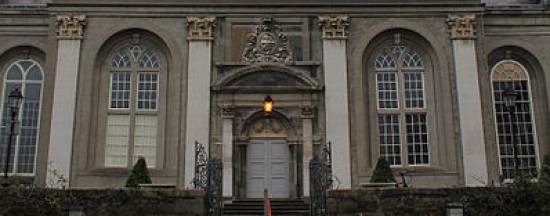The Royal Hospital Kilmainham is a 17th Century building modelled on Les Invalides in Paris as a retirement home for old, sick and disabled soldiers. The building contains the Master’s Quarters, the Great Hall, the Chapel, a magnificent Courtyard and a Vaulted Cellar. There are notable formal gardens. The Royal Hospital Kilmainham predates its sister, the Royal Hospital Chelsea, by just two years and is the oldest classical building in Ireland.
The Royal Hospital stands on the site of the 7th century Early Christian settlement of Cill Maighneann, from which the area of Kilmainham derives its name.
In 1174, Strongbow developed the site replacing the Christian settlement with a medieval hospital and monastery of the Knights of St. John of Jerusalem (Knights Hospitallers).
With the dissolution of the monasteries under the rule of Henry VIII between 1536 and 1541, the settlement was closed and the lands remained vacant until 1680.
The Royal Hospital Kilmainham was established and built between 1680 and 1684 on a 60 acre site granted by King Charles II at the instigation of James Butler, First Duke of Ormond.
Inspired by ‘Les Invalides’ in Paris, France, then recently opened as Louis XIV’s home for his army pensioners, Ormond obtained a charter from King Charles to construct a similar type of building at Kilmainham.
A retirement home for old soldiers rather than a hospital, the building opened its doors in 1684 and for the next 243 years, thousands of army pensioners would live out their final days within its walls.
Classical in design and Continental in layout, leading architects such as William Robinson, Thomas Burgh and Francis Johnson worked on the building making the Royal Hospital not only a building of distinction, but the starting point of Dublin’s development into a city of European standing.
In the 19th century, the military significance of this building was greatly enhanced when it became the residence and headquarters of the Commander-in-Chief of the British army in Ireland.
The Royal Hospital remained an old soldier’s home until 1927 when it was finally handed over to the newly established Irish Free State Government, where it served a number of purposes in the decades that followed (including serving as Garda Headquarters from 1930 to 1950).
In 1980 Taoiseach Charles Haughey approved plans to renovate the building at a cost of IR£3 million. It took four years to complete the project – which is as long as it took to originally build it three centuries before!
Today, the Office of Public Works retells the story of this magnificent building through its ‘Old Man’s House’ Exhibition. Visitors can discover the history behind the North Range, the Formal Gardens, the Meadow and Dublin’s Oldest graveyard, Bully’s Acre. Located on the ground floor of the West Wing, the exhibition enables one to enter a window into the past, learning about the lives of those who once worked and resided within its walls.
The building became home to the Irish Museum of Modern Art in 1991 (please click here for more information about IMMA).
You can read a full account of the Hospital’s fascinating history at www.imma.ie
Opening Hours:
Monday- Saturday: 10am – 5pm
Sunday and Bank Holidays: 12pm – 5pm.
The modern art gallery is closed on Mondays.
The Royal Hospital Kilmainham is open all year for historical guided tours of its spacious grounds. Unfortunately, as part of the building is closed for refurbishment, there is limited access to the interior. Tours of the grounds and gardens are available daily for free but booking is required.
Contact & Pricing:
rhk.ie
[email protected]
[email protected]
Tel: 01 612 9903 (General enquiries) / 046 9422450 (Tours)
Military Road, Kilmainham, Dublin 8
Admission free
